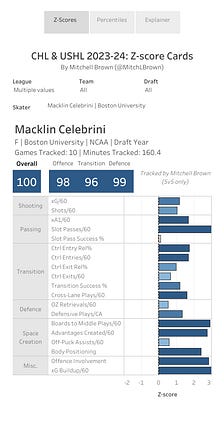The app for independent voices
Evergreen note: “Analytics” are not mere numbers. They’re models: ways of bridging practical (what happens on ice) and theoretical knowledge (what will or can happen based on prior events). They help define the conditions of performance over a period of time rather than merely reference a series of outcomes the way plus-minus does. The climate versus the weather; defining the signatory rather than just the signature. These are not meant to be a right or wrong way to look at a hockey game; they’re meant to be useful in understanding the conditions of hockey itself.
The Stat: Mitchell Brown and Lassi Alanen’s prospect tracking
The question Brown and Alanen’s data aims to answer: How does a prospect perform, in all three zones, from shift to shift?
How it answers that question: Inspired by Corey Sznajder’s All Three Zones project, Brown and Alanen do something similar, but for prospects. Attached is a chart for the top player in the 2024 draft, Macklin Celebrini. The data is arranged by percentile. So we see that overall Celebrini ranks in the 100th percentile, meaning he has no peers. Offensively, he ranks higher than 98 percent of his colleagues. In transition, he ranks higher than 96 percent of this year’s draft class, and defensively, he ranks higher than 99 percent. Before moving into the meat and potatoes, I want to mention the Z-Score at the bottom. The positive/negative numbers represent deviations from the mean. How far from the mean is Celebrini? The further to the right, and darker the gradient (indicated in blue), the better. The further to the left, and darker the gradient (indicated in red), the worse.
As far as the tracked data itself, I’m gonna go over only a few, because some of these speak for themselves, but also — they have a glossary that’s easy to understand that I’ll link to.
xG: Brown’s model is quick and dirty. To weigh the likelihood of a shot becoming a goal, Brown uses shot location, shot type, preceding passes, and rebounds. This is not as high level as Goals Above Replacement or Synthetic Goals, but it’s still a quality metric that gives us something more than simply the outcome of a player’s shot.
xA1/60: This is a cool stat. An expected primary assist is a pass given weight by whether or not the pass connected with a shot following the xG spectrum. The only reason why I don’t think a stat like this would have as much weight for NHL models is that I don’t think passing is as creative or free-flowing at the higher levels. Just my opinion though.
Defensive Plays/CA: How often a player disrupts possession, through break ups, interceptions, forced shots due to pressure, and recovered dump-ins. Great little stat that compiles a lot of a defender’s most essential work in their own zone with the puck.
Boards to Middle Plays/60: In recent years, being able to get off the wall quickly, going from outside to inside, to generate shots is becoming a premium skill as teams clog lanes tighter than ever. Dallas’ young prospects like Johnston, Stankoven, and Bourque in particular excel at this.
Off-Puck Assists/60: This is a unique stat, and something mercurial. This refers to how often a player is involved in a chance that they didn’t touch the puck on. So stick lifts, net drives, and screens are tallied here.
Offense Involvement: A player’s percentage of the team’s total xG they either set up or shot themselves.
You’ll see a lot of these whenever I cover the draft or prospects in general. Along with Scouching (which will have its own explainer), they’re my go-to when I want a bird’s eye view of what a prospect did or did not accomplish within the sequence of tracked games. It’s not a substitute for scouting, but as always, I think the relationship between what we see, and what we catalog should be in constant dialogue. After all, we aren’t simply trying to describe players. We’re trying to categorize them; and that takes more than simply watching what a prospect can do. That’s an importance piece when evaluating the draft: they don’t exist in a vacuum. We’re ranking them, which means a constant tug-of-war between profiling and cross-referencing.
For a complete glossary, click the link below:

